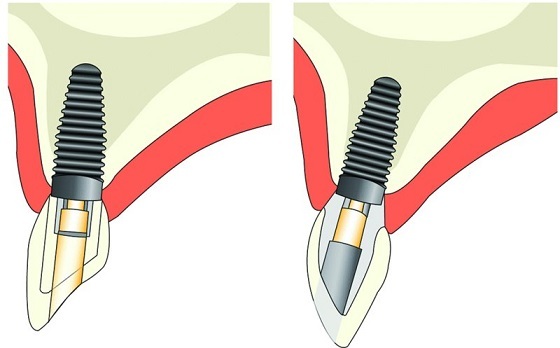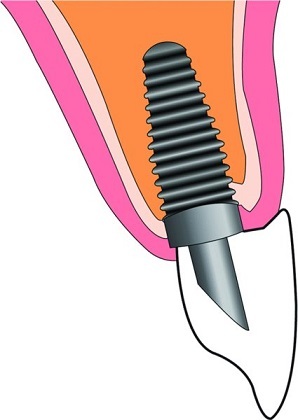Screw versus Cemented Implant-Supported Restorations
Christopher C.K. Ho
Principles
An implant-supported restoration can be inserted onto an implant by either attaching it to the implants with screws or cementing it onto abutments that have been secured by screws. There are advantages and disadvantages to each procedure, and the decision of whether to screw retain or cement a restoration is often dependent on the implant position and clinician preference.
The factors that determine the decision are outlined in the following sections.
Retrievability
Screw retention allows the ability to remove a restoration for repair, prosthetic modification or soft-tissue inspection, and creates access for hygiene if required. Many clinicians prefer to treat implant restorations similarly to conventional crowns and bridgework, cementing the final restoration and, if there is any maintenance required such as screw loosening, then destroying the restoration and replacing it accordingly. The incidence of screw loosening has diminished with improved screw-joint mechanics and connections, although it may still occur. When abutment screws loosen, cement-retained restorations are not always predictably removed from abutments to allow screws to be re-tightened, and hence the restoration may need to be removed. This would often destroy the restoration and render it unusable. Thus it would be prudent and simpler to manage if the restorations were planned for screw retention where, if a problem did occur, the restoration could be accessed through the screw hole, removed and tightened. Additionally, as the complexity of the restoration and the number of units increase, the expense of re-making an extensive restoration becomes untenable for the patient, so retrievability is paramount. Alternatively temporary soft cement can be used to cement the final restoration, this will require an accurate fit of the restoration to minmise the risk of inadvertent decementaion and preserve retrievability.
Aesthetics
Screw retention requires a screw-access hole to be made through the restoration that is normally restored with composite resin once the restoration is in place. In the anterior region of the mouth screw retention may not be possible due to implant position, as having a screw access in a visible area, such as the labial face of a maxillary incisor, is unacceptable (Figure 11.4.1). When screw access to the implants is in aesthetic areas, the screw access can be re-aligned with the use of angulated abutments, or the restoration should be retained with custom abutments and cemented. Screw-retained restorations can only be used when the trajectory of the implant allows the screw access to be in a non-aesthetic area. There are also clinicians who object to having a hole in the restoration that is restored with composite resin, as this may wear and discolour over time. Additionally, to achieve screw retention in the anterior region often involves aligning the implant slightly more palatally in the anterior maxilla to allow screw access in the cingulum area, which may leave a ridge lap or unaesthetic crown.

Figure 11.4.1 Screw-retained crowns require an access hole on the cingulum area to enable access to the screw. The image on the right demonstrates the alignment of the implant, with the access to the screw leading to a hole on the labial surface of the crown, which would not be acceptable and necessitates a cement-on crown
Passivity
A passive fit is desirable for implant restorations, as stress to an implant may overload the prosthesis, causing a technical complication, or lead to strain between the bone interface and implants, resulting in peri-implant bony changes. It has been advocated that one of the advantages of cement-retained restorations is that frameworks are more passive, as the abutments are individually retained to the implants by screws and the restoration is cemented over the abutments. This cement space allows for passivity, on the assumption that the cement acts as a shock absorber and reduces stress to the bone and implant interface. There is very little evidence to support this theory, however. Impression taking and handling of the casts are crucial to minimise errors and the advent of CAD/CAM milling has eliminated many of the errors from casting and metal work. Due to the passive fit, there is a belief that there is less fatigue and fracture of componentry, and that should there be overloading forces to the restoration, the cement layer would fail first, thereby saving the implant and restoration from failure.
Hygiene (Emergence Profile)
To achieve screw access in maxillary anterior implant restorations, it may be necessary to align an implant in a more palatal trajectory, which may leave the implant more palatally placed, especially in a resorbed alveolar ridge. The final restoration may thus possess a ridge lap and subsequently be more difficult to clean effectively, or there may be an unaesthetic appearance (Figure 11.4.2).

Figure 11.4.2 Achieving screw retention in the anterior region may involve aligning the implant slightly more palatally in the anterior maxilla to allow screw access in the cingulum area, which may leave a ridge lap or unaesthetic crown
Reduced Occlusal Material Fracture
A screw-retained restoration will have a screw-access hole, which disrupts the structural continuity of porcelain, leaving some unsupported porcelain at the hole. Cemented restorations are one piece without any weakening of the structure of the crown. However, it should be noted that if veneering porcelain chips or fractures off an implant restoration in a screw-retained restoration, it would be a relatively simple procedure to remove and carry out an indirect repair on the implant restoration.
Interarch Space
Stay updated, free dental videos. Join our Telegram channel

VIDEdental - Online dental courses


